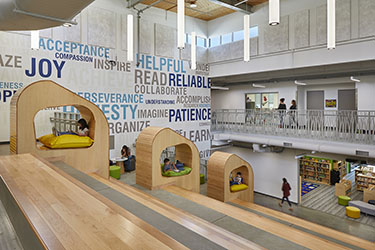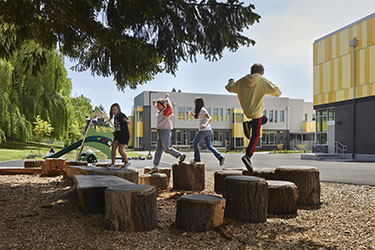|
Subscribe / Renew |
|
|
Contact Us |
|
| ► Subscribe to our Free Weekly Newsletter | |
| home | Welcome, sign in or click here to subscribe. | login |
Construction
| |
 |
September 30, 2021
Trauma-informed design in schools
Bassetti Architects

McConachie
|
Supporting traumatized children is a critical issue facing our schools. Mid-pandemic, 90% of our children have experienced toxic stress. Over 60% of our kids have experienced trauma.
The trauma can range from substance abuse, violence and homelessness to poverty, racism and the pandemic. Trauma alters brain function. Critical thinking skills are overwhelmed by a focus on hypervigilance and survival. Triggering causes difficulty regulating emotions and trouble with attention, memory and learning. Our most vulnerable children from marginalized communities are the worst hit.
While a caring adult and supportive school culture are the first lines of defense, the built environment can play a crucial role. In response to the challenges, Bassetti Architects has been compiling “best practices” of trauma-informed design (TID) as a tool to assist designers and educators to think creatively about shaping supportive learning environments. They developed a TID checklist compiled of research and lessons learned from trauma-informed care practitioners and educators.
Truman Elementary School in Vancouver incorporates many ideas in the TID checklist. The replacement school was planned for 600 students of diverse backgrounds including: 60% eligible for free and reduced lunch, 20% English-as-second-language learners, and a transient population of 20%. This diversity led school staff to emphasize equal opportunity for all students regardless of economic, transience or language barriers.
The inspiration for trauma-informed design grew out of our work with the gifted Truman faculty. Principal Theresa Davis-Turner summed up the dedication:
“At Truman we say all students are my students. We share the responsibility for the education and well-being of all Truman students. This is evident in our intentional design to provide flexible shared open spaces (learning studios and learning stairs) that classrooms can extend into. The design process was incredible. Truman teachers described our work while Bassetti staff listened and then designed a structure to support the work we described. This collaboration produced a building that provides multi-tiered supports for academic and social/emotional learning.”
Davis-Turner’s summary centers on educating the “whole child” — encompassing the academic, social, emotional and physical needs of each student. The subsequent design provides a learning environment that supports academic success coupled with the social/emotional needs of students.
Truman is organized around a central entry with quieter learning studios to the south and energized movement/gathering spaces to the north. Traditional school spaces — classrooms, library, cafeteria — are augmented with safe spaces where counselors, therapists and psychologists can work directly with students.
The welcoming entry enhances the involvement of the broader community in student success. Arrival occurs at a highly visible drop-off/gathering area. This visibility is critically important for students dealing with trauma who can be hyper-vigilant as to “who’s coming and going.” Adjacent to the entry is the Family-Community Resource Center dedicated to family-focused uses. It serves as an essential nexus of communication between parents, volunteers, school staff and caregivers providing services to children facing trauma.
The south wing of the school contains six learning studios surrounding a centralized library, art lab, maker lab, and multi-use learning stair uniting the two stories. Both learning studios and centralized shared spaces were designed with an eye to academic excellence and TID.
The learning studios house layers of spaces with perimeter classrooms, shared co-op spaces, small group areas and project-based learning studios. The spaces support personalized and differentiated learning pathways for each student. The flexible, open concept with ample acoustic attenuation adapts to one-on-one, group, or hands-on learning while enhancing vital collaboration among teachers.
The variety and scales of spaces are also important in supporting traumatized children. Kids dealing with acute stress often need help from counselors and/or a place of refuge to rebalance. Individual or small group learning can be critical for re-engagement. Project—based learning studios and flexible co-op spaces support all children in their natural urge to explore, tinker and create. Exploratory projects can also help traumatized students refocus.
Additionally, Truman houses four specific layers of support for children struggling with emotional balance. First, each classroom offers a light-filled bay window with a comfortable bean bag to help children gather themselves, nap or just cool down. The importance of emotional recognition and self-regulation without removal from class is critical.
The second layer, within the shared co-op space, is a graphic sensory circuit that helps students, needing to move or fidget, reset themselves. Third, an adult-supervised motor support circuit designed for children working through deeper emotional challenges. The final layer is a safe room with soft finishes where children who are terrified, angry or out of control can let out their rage under the watchful eye of a caring adult. The dreadful impacts of trauma can vary from a need for quiet withdrawal to screaming anger.
Centralized spaces in the learning studios provide vital shared resources for all students and places of refuge within eyesight of caring adults for children dealing with trauma. These spaces support large and small group learning. Flexible furniture, cozy corners, niches, nests and thoughtful transparency offer children a variety of places that can be transformed to meet their needs. Whether a student is retreating from bustling daily activities, observing others but not ready to participate, or engaging with classmates in collaborative exploration, learning areas at Truman provide spatial options to support both academic and social/emotional needs.
The school’s more active north wing houses movement, dance, music, physical education, performance, dining and gathering spaces. A “fitnasium,” in lieu of a gymnasium, encourages movement in all forms both indoors and out. The multi-use commons is a large flexible space used for daily lunch and whole school gatherings. A raised platform supports presentations and benches provide students a safe perch along the edge of the busy space.
The commons opens to a playground and grove of mature trees where biophilic connections invite play and stress reduction. Structured and unstructured play provides children with choices in the type of activities in which they engage. All children, particularly those experiencing trauma, can choose between individual, small or large group activities. A courtyard connecting the north and south wings provides secure enclosure, a place for reflection, or cloistered outdoor learning.
From its inception, Truman Elementary School sought overarching design characteristics supporting academic excellence and social/emotional well-being. As our schools emerge from the damaging impacts of the pandemic, we must take account of the debilitating effects of traumatic stress our children have experienced. Whether a simple remodel funded by the American Recovery Act or new construction, the thoughtful inclusion of trauma-informed design ideas can help shape educational environments for healthy, engaged learners.
Lorne McConachie is a principal of Seattle- and Portland-based?Bassetti Architects, where he has cultivated a 36-year career of creating personalized, collaborative spaces that support differentiated learning, engaged communities and sustainable connections to place.
Other Stories:
- Nature and nurture in Renton's Cascade/Benson Hill neighborhood
- Exploring the benefits of mass timber
- School ventilation strategies for a pandemic
- How schools and designers can manage crises
- Effective learning design in the state-of-the-art Honouliuli Middle School
- Strategic energy planning for equity and resilience
- Providing for diversity in K-12 schools
- Progressive design-build is changing the future of K-12 construction




